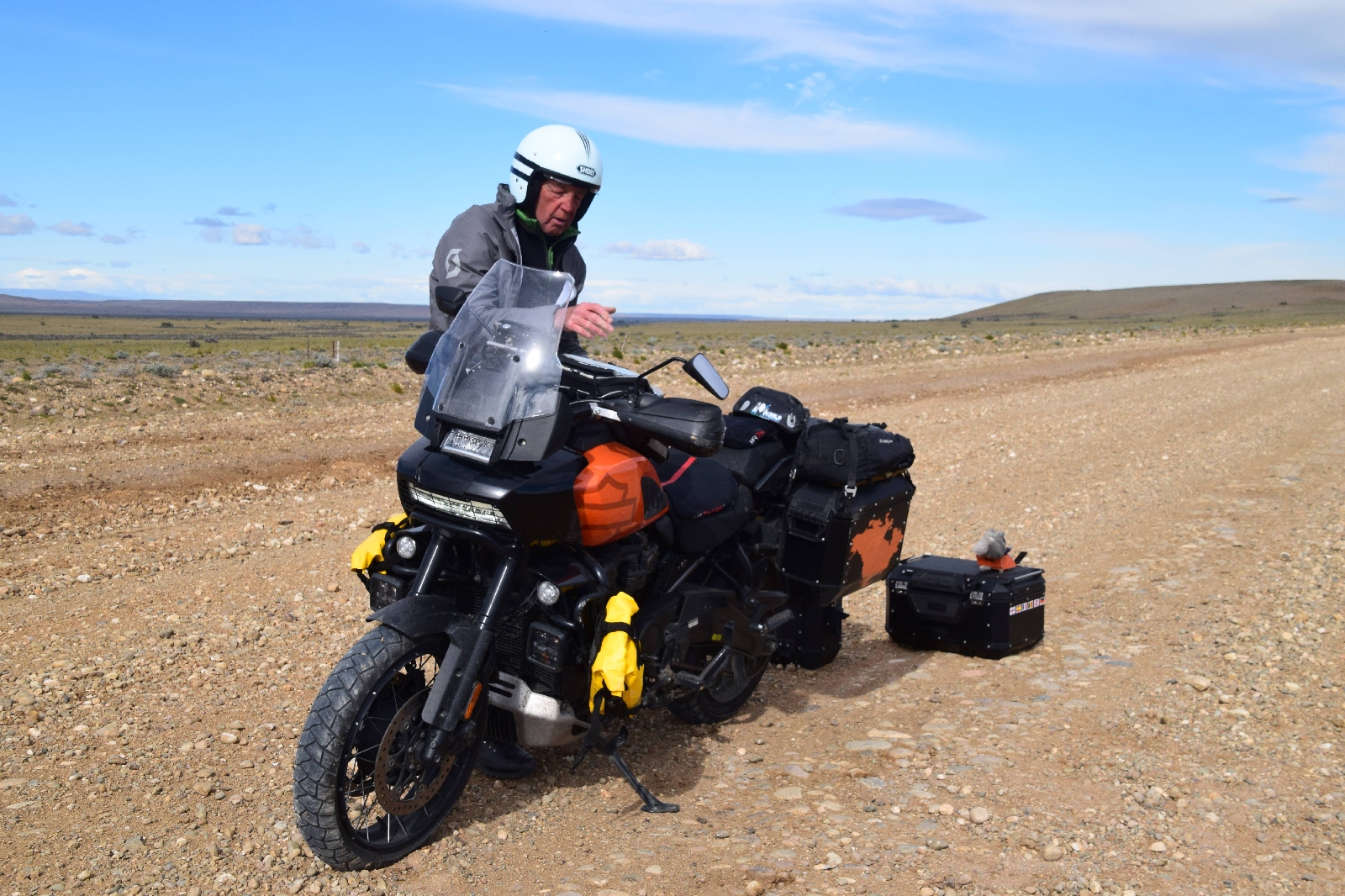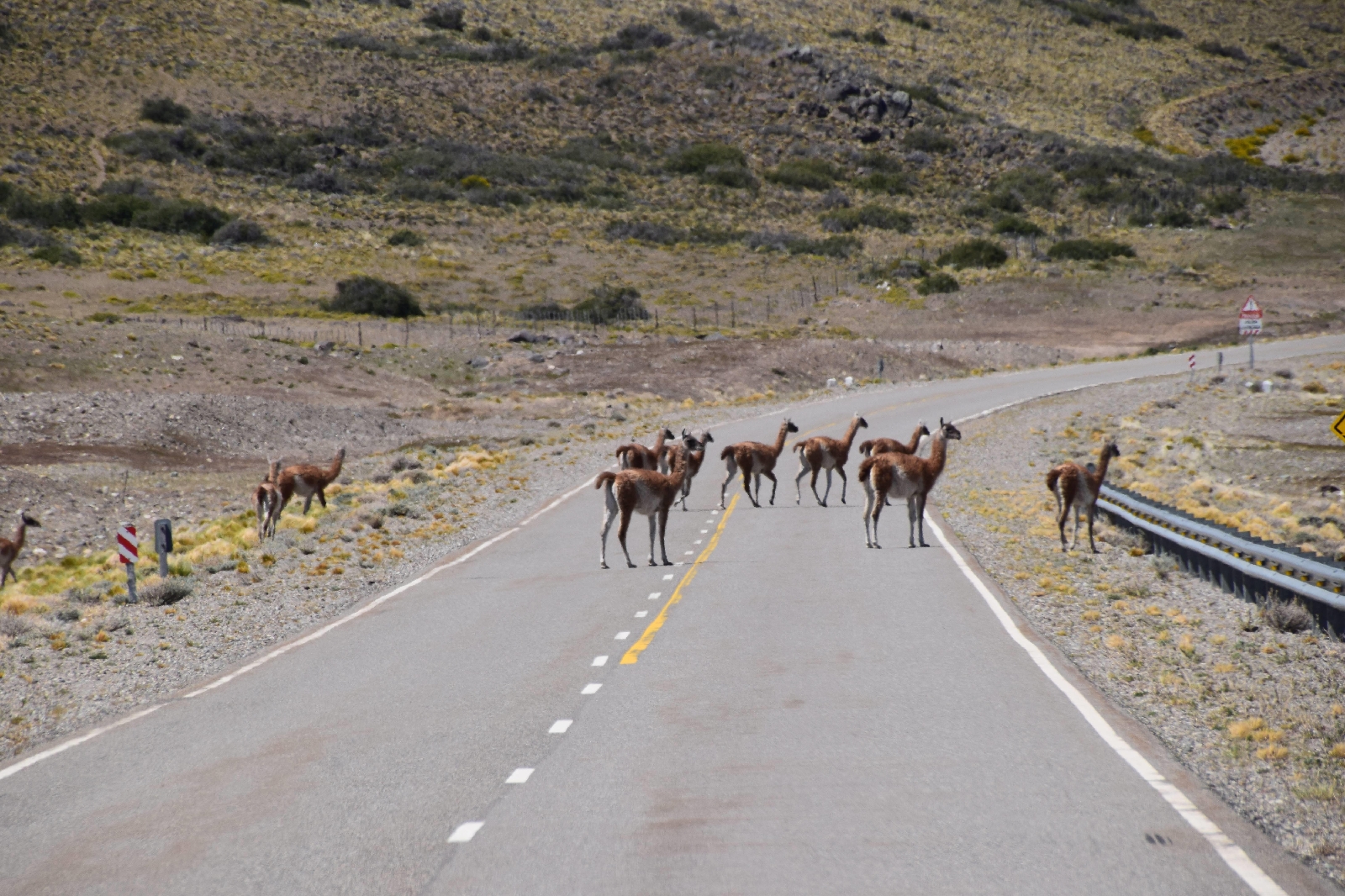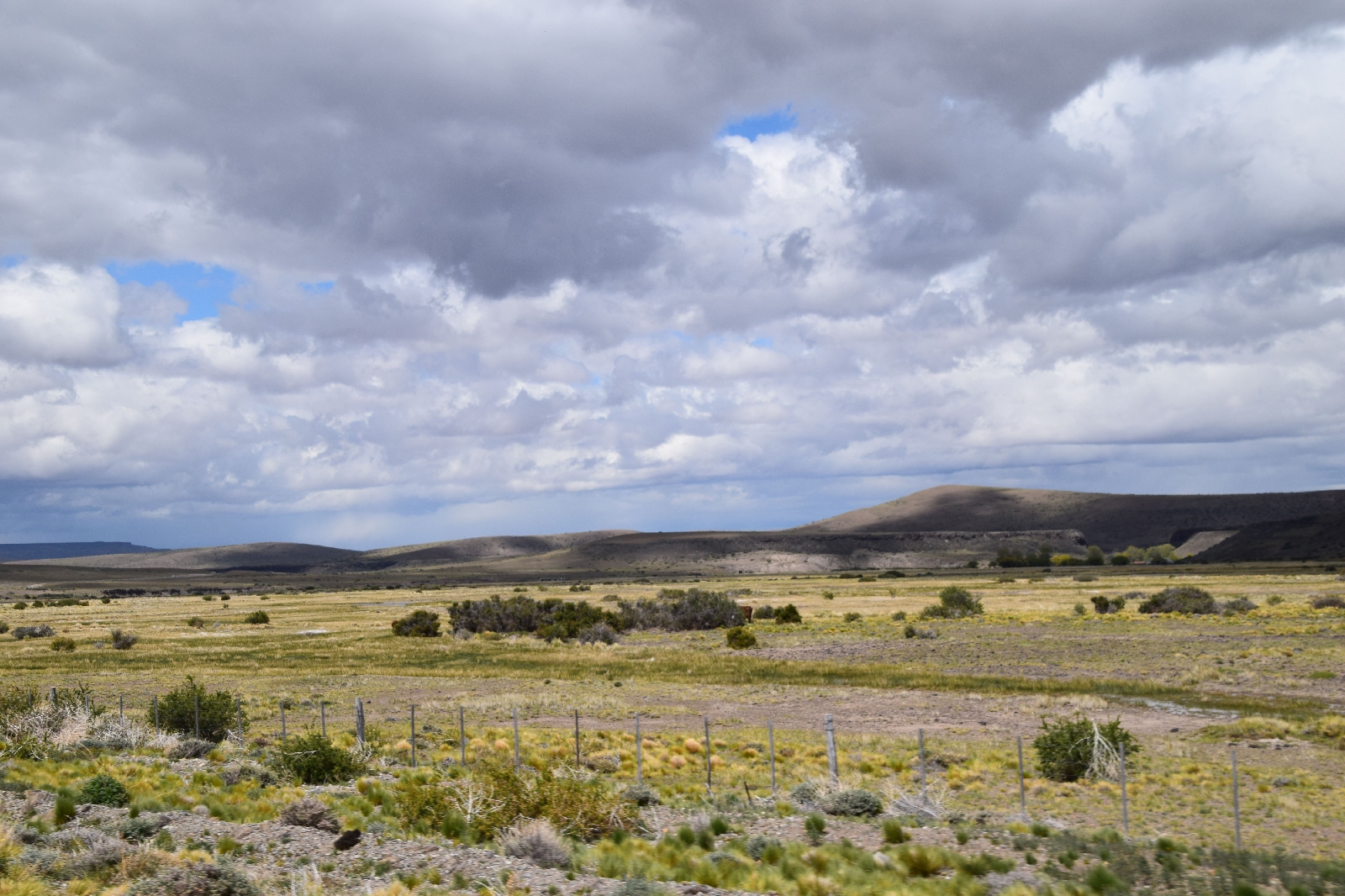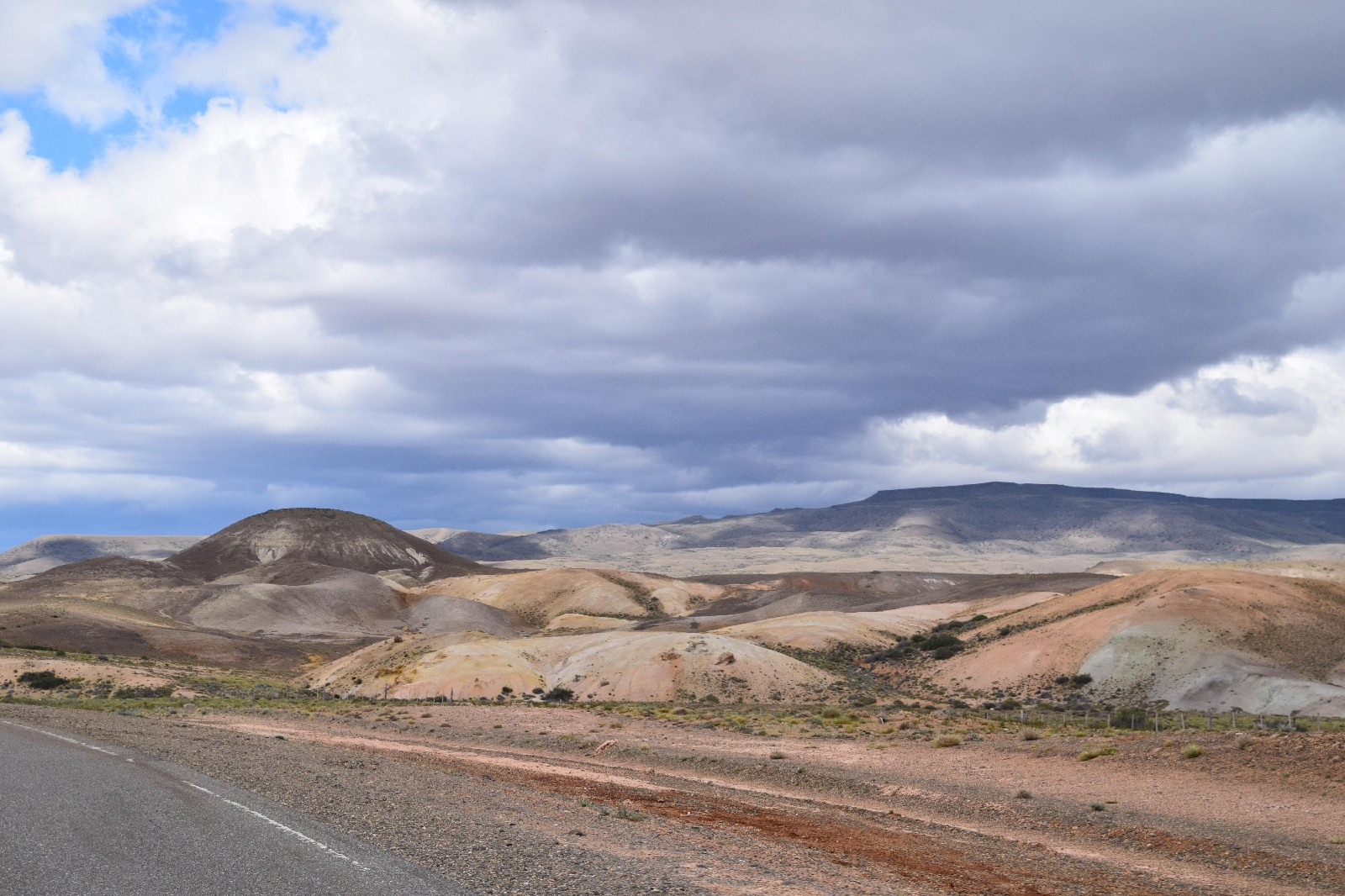To get to the interesting Chilean bits we needed to get to Perito Moreno in Argentina, the town not the Glacier; the two being hundreds of kms apart. This left us with an interesting dilemma and three options. The direct route had a 73km section of Ruta 40 of gravel 'road' called the 'Damned 73km' which consists, we were told, of deeply rutted soft gravel. The second option avoided this section altogether but replaced it with a 130km section on gravel in better condition and a further 130km of tarmac. The third option was to backtrack, cross over to the East Coast and then come back North again which would have meant rather a lot of extra kms. We chose option 2.
As it would otherwise have been a very hard day we decided to have a short day and just ride 160km to Tres Lagos which was the start of the two gravel roads. On the way to Tres Lagos we stopped at La Leone for coffee. A building not a town, but a building where Butch Cassidy and the Sundance Kid were said to have spent the night.
Tres Lagos was interesting as there was no sign of one lake let alone three and although it was a big enough town to appear on our map of Argentina, it was a one road town with a few gravel spurs off it. We had a cabana booked for the evening but that doesn't come with any food which we eventually found at an out of season campsite. Who camps in 50km/h winds?
The winds are predominantly from the west and we congratulated ourselves on choosing Option 2 as that meant the wind was behind us whilst we were on gravel and we would have the crosswind whilst on tarmac. Not only would we have had to deal with the deep rutted gravel on Option 1, but also the crosswind as the road is primarily North-South.
Winds pick up during the day, so we decided to set off early; with a cup of green tea and some lemon cake from the campsite from the night before for breakfast we were on the 'road' for 06.20.
We will never know whether it was the right choice or not - and we are not going back to test the options. We found it very hard going indeed. Very tiring and very difficult to stop - not that there was even a tree to stop by. This was a main road in the Argentinian system. Paul does not have the confidence to ride at speed on the gravel. It took us 7 hours to complete the 130km. Towards the end we did try to stop every 10km for a rest - for us and the bike. In addition we also dropped the bike twice, which means that the panniers now have some small war wounds. The first time we fell, Paul's foot got trapped under the bike but there was no weight on it and a combination of Paul pushing on the seat with his other foot and Francoise trying to lift the bike a bit freed Paul. Francoise also banged her ribs and is still feeling sore now, a few days after. No further personal injuries with the second fall. The falls were not at high speed -130km in seven hours after all! They were due to Paul feeling he was losing control of the bike and having a reflex action of touching the front brake. The bike could do with a button gadget that disconnects the front brake when on gravel.
We have reflected a lot on this experience. During the seven hours on the gravel not one vehicle passed us in our direction. In the opposing direction there was a grader pushing gravel which made it worse for us as had no tracks to follow. It was a one man, one machine operation and further along there was a parked lorry with a hut on the back which was presumably for the grader driver. A lorry carrying hay and a German camper van also passed in the opposite direction. That was all we saw in seven hours. We might have an Argentinian SIM card in our phone, but there are no radio masts so no coverage so the phone is useless really except in towns. We don't have a satellite phone. So what would have happened if we hadn't been able to get Paul's foot from underneath the bike? Or that we had been more seriously hurt? Or that something had happened to the bike? Or we hadn't been able to right the bike? The bike has actually behaved immaculately since its initial trauma of finding itself in Uruguay.
Who knows whether we might actually have been better taking the more difficult, shorter route simply from the point of view that there would have been more passing traffic in case of an emergency? The middle is big in Argentina and it has a big nowhere. The main driver for us choosing Option 2 was that our priority was to get to our planned end of the trip rather than collect badges for doing difficult things along the way. So we are now revising our plans such that we try and stay on paved roads. The bike is capable of a lot more but we aren't and the priority remains getting as close as possible to our planned end. There are places we won't now visit - but equally there are now places we will visit that we had not planned too.
After our difficult day we used the following day to ride to the town of Perito Moreno. We reserved a log cabin on the side of Lago Buenos Aires for a couple of days to be away from everything and rest. There was a kitchen there with a log fire - we need it, we are still after the promised temperatures higher than low teens and no more reductions for wind chill please!
But the road to Perito Moreno at least had some scenery for 30 minutes.
On the way we stopped at a petrol outpost - difficult to call it a petrol station. It had a cafe but we had to go without as we are now seriously running out of cash and they wouldn't take cards. We had enough petrol but the coffee would have been nice. Whilst there for no more than a ten minute loo break we were hailed by a bike we had met in the shop in Montevideo where we bought the new battery. Small world?
This has now happened to us a number of times on this trip. Gonzalo who we bought the battery from in Montevideo saw us at a beach just on the outskirts of Montevideo, we met a solo German biker on the ferry to Tierra del Fuego and saw him again four of five days later when we were riding into Punta Arenas in Chile. One of the guys who helped us through the snow at Ushuaia tooted us in the afternoon as we walked through the city. A Brazilian biker who stayed in the same hotel as us in Rio Grande saw us again at a petrol station in El Calafate. We met Salvador's (wonderful motorcycle shop in Punto Arenas) daughter whilst she was riding off road around Torres del Paine. We then met the same Uruguayans at another petrol, station in Perito Moreno town and then met their friends who we had also met in Gonzalo's battery shop in Montevideo the following day at the same petrol station. It's not just that we met them They embrace us like long lost friends and offer to help us with anything we might need. It makes us quite emotional.
Our rest day at Perito Moreno didn't quite go to plan. We are seriously running out of cash and not everyone is taking cards. We can now only sleep, eat, drink or get petrol at places that take cards. Another factor that comes into planning the route. On our rest day we went to the banks. The banks will only let us take out 5,000pesos (£5.00) with our cards. And for this they would charge 4,500pesos. We haven't tested whether we would get the 5,000 or not. We went to Santa Cruz bank that had no cash available at all except for that in the ATMs which stubbornly refused to give us cash. We went to the National Bank of Argentina and the Assistant Manager assured us that we were being silly and that of course the ATMs would give us money - but he could not engender a better result from the ATMs either and they could not do anything over the counter with our cards. So we looked up what others do in such situations on the internet and the answer was they use Western Union to send money to themselves from their home bank to be changed into Argentinian pesos and then collected at any Western Union agency in Argentina. So we did this. But none of the five agencies we visited had any pesos whatsoever. We have no idea how Argentinians manage the situation themselves or even whether we will ever be able to collect the money we have wired to ourselves. Maybe when we are in a bigger city somewhere out of this disproportionately large middle of nowhere? Maybe we should have ignored the intrnet and its 'advice' about not carrying too much cash in South America. Well we certainly aren't now!
Onwards, to the North!





















